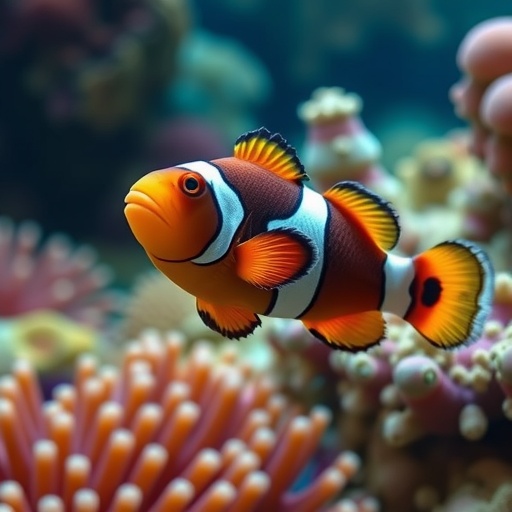Anemonefish, widely beloved as charismatic reef dwellers, have long captivated scientists with their intricate relationship with sea anemones. Traditionally, this mutualistic association has been cited as the primary driver behind the remarkable diversification observed within the Amphiprionini lineage, commonly known as clownfish. However, a groundbreaking international study challenges this entrenched paradigm, revealing a far more nuanced ecological and evolutionary landscape underpinning their adaptive radiation. Employing a suite of integrative methods—spanning field observations, laboratory assays, hydrodynamic modeling, and detailed morphometric analyses—researchers have uncovered novel strategies involving muscle physiology and swimming dynamics that defy the simplistic specialist-generalist dichotomy.
Central to the study was the examination of fourteen distinct clownfish species, meticulously selected to cover a broad spectrum of ecological traits and anemone host affiliations. Through an innovative phenotyping framework, the team identified discrete eco-morphotypes that operate independently of host specificity. The classical model, which rigidly categorized species as “specialists” inhabiting one or two sea anemone species versus “generalists” exploiting up to ten host types, fails to capture the complexity unveiled. Certain larger clownfish species, endowed with robust musculature and consequently reduced energetic costs during locomotion, engage in expansive exploratory behaviors, frequently venturing away from their anemone hosts. Alternatively, smaller, more slender species exhibit heightened metabolic rates and remain predominantly sedentary, closely anchored to their protective anemone microhabitats.
This paradigm shift emerged through comprehensive physiological measurements, including oxygen consumption metrics that revealed differential energy expenditures congruent with morphological traits. Complementing these data were swimming speed assays and three-dimensional hydrodynamic simulations based on microtomographic scans, enabling precise quantification of biomechanical efficiency across species. Such integrative analyses revealed two predominant morphotypes: “adventurous” fish capable of sustained, low-energy swimming over long distances, and “sedentary” counterparts constrained to short-range movement with elevated metabolic demands. Intriguingly, an intermediate morphotype was also suggested, exemplified by Amphiprion frenatus, featuring traits bridging the two extremes.
Beyond biomechanics, evolutionary reconstructions rooted in molecular phylogenetics illuminated that these eco-morphotypes emerged independently multiple times throughout clownfish evolution, demonstrating a compelling case of convergent evolution. This discovery underscores that adaptive radiation in anemonefishes operates along multifaceted ecological axes, combining habitat dependence with novel physiological adaptations. The clade, therefore, parallels iconic evolutionary radiations such as Darwin’s finches and African cichlids, offering a powerful model system for dissecting diversification mechanisms.
The ecological ramifications are profound. The locomotor capabilities and behavioral tendencies of clownfish likely influence dietary breadth, niche partitioning, and social hierarchies within reef communities. Species that can traverse broader reef expanses may exploit diverse food sources and engage in complex interspecific interactions, while sedentary species might rely more intimately on their host anemones not only for shelter but also for sustenance and social structure. Such dynamics could, in turn, shape the nature of their cohabitation with other clownfish species, an aspect vital to understanding species coexistence on heterogeneous coral reefs.
Technically, the study’s innovative combination of microtomography and hydrodynamic modeling sets a new standard in functional morphology research. The muscle architecture revealed by microtomographic imaging allowed precise biomechanical inference, linking tissue composition with swimming efficiency. Concurrently, leveraging computational fluid dynamics simulations enabled visualization of flow patterns and drag forces experienced by different morphotypes, facilitating accurate assessments of energetic expenditure during locomotion. This level of integrative phenotyping transcends traditional ecological observational studies, marrying morphology, physiology, and behavior in an evolutionary framework.
Furthermore, the implications extend to conservation strategies. Understanding the adaptive capacities and ecological niches of various clownfish species aids in predicting their resilience or vulnerability under changing environmental conditions, such as habitat degradation and warming oceans. Species characterized by low mobility and high dependence on specific microhabitats may face higher extinction risks, whereas “adventurous” morphotypes could potentially adapt or migrate in response to ecological disturbances.
The research also prompts intriguing questions about the co-evolutionary dynamics between anemonefishes and their hosts. While the defensive stinging tentacles of sea anemones have long been considered the cornerstone of clownfish survival, these findings suggest that muscular and metabolic adaptations in the fish themselves are equally pivotal. Understanding how such traits evolved in concert with host affiliation patterns provides an enriched perspective on mutualism and evolutionary innovation.
This integrative study also aligns with prior research from the same laboratory, which investigated the evolution of color pattern diversity in clownfish. Together, these works establish the Amphiprion genus as a versatile model system for probing evolutionary connections between form, function, and ecological specialization. More broadly, they illustrate the power of combining phylogenetics, biomechanics, and field ecology to unravel the intricacies of adaptive radiation.
In conclusion, the study fundamentally reshapes our comprehension of clownfish evolution by revealing that specialization to sea anemone hosts is only part of a complex adaptive mosaic. Muscle strength, energetic metabolism, and behavior contribute essential axes of diversification, broadening the conceptual framework around ecological specialization in reef fishes. As researchers continue to refine methodologies and expand taxonomic breadth, the anemonefish radiation promises to illuminate general principles about the interplay of ecological pressures and evolutionary innovation across marine biodiversity.
Subject of Research: Adaptive radiation and ecological diversification in anemonefish (clownfish), focusing on muscle physiology, swimming energetics, and host specialization.
Article Title: Integrative phenotyping reveals new insights into the anemonefish adaptive radiation
News Publication Date: 3-Jul-2025
Web References:
http://dx.doi.org/10.1016/j.cub.2025.06.041
Image Credits: Manon Mercader
Keywords: Anemonefish, Amphiprion, adaptive radiation, muscle physiology, swimming energetics, mutualism, sea anemone, evolutionary convergence, biomechanical modeling, coral reef ecology




